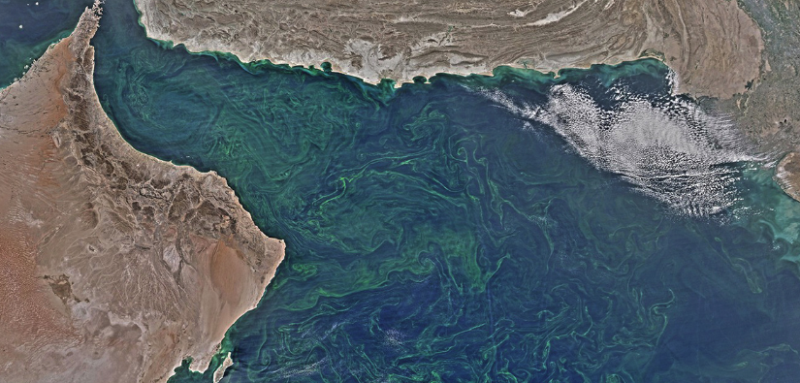File:Oceans losing oxygen-NASA.png
Oceans_losing_oxygen-NASA.png (800 × 383 pixels, file size: 799 KB, MIME type: image/png)
<addthis />
Declining oxygen in the global ocean and coastal waters
January 5, 2018
http://science.sciencemag.org/content/359/6371/eaam7240
___________________________________________
Beneath the waves, oxygen disappears
As plastic waste pollutes the oceans and fish stocks decline, unseen below the surface another problem grows: deoxygenation. Breitburg et al. review the evidence for the downward trajectory of oxygen levels in increasing areas of the open ocean and coastal waters. Rising nutrient loads coupled with climate change—each resulting from human activities—are changing ocean biogeochemistry and increasing oxygen consumption. This results in destabilization of sediments and fundamental shifts in the availability of key nutrients. In the short term, some compensatory effects may result in improvements in local fisheries, such as in cases where stocks are squeezed between the surface and elevated oxygen minimum zones. In the longer term, these conditions are unsustainable and may result in ecosystem collapses, which ultimately will cause societal and economic harm.
BACKGROUND
Oxygen concentrations in both the open ocean and coastal waters have been declining since at least the middle of the 20th century. This oxygen loss, or deoxygenation, is one of the most important changes occurring in an ocean increasingly modified by human activities that have raised temperatures, CO2 levels, and nutrient inputs and have altered the abundances and distributions of marine species. Oxygen is fundamental to biological and biogeochemical processes in the ocean. Its decline can cause major changes in ocean productivity, biodiversity, and biogeochemical cycles. Analyses of direct measurements at sites around the world indicate that oxygen-minimum zones in the open ocean have expanded by several million square kilometers and that hundreds of coastal sites now have oxygen concentrations low enough to limit the distribution and abundance of animal populations and alter the cycling of important nutrients.
ADVANCES
In the open ocean, global warming, which is primarily caused by increased greenhouse gas emissions, is considered the primary cause of ongoing deoxygenation. Numerical models project further oxygen declines during the 21st century, even with ambitious emission reductions. Rising global temperatures decrease oxygen solubility in water, increase the rate of oxygen consumption via respiration, and are predicted to reduce the introduction of oxygen from the atmosphere and surface waters into the ocean interior by increasing stratification and weakening ocean overturning circulation.
In estuaries and other coastal systems strongly influenced by their watershed, oxygen declines have been caused by increased loadings of nutrients (nitrogen and phosphorus) and organic matter, primarily from agriculture; sewage; and the combustion of fossil fuels. In many regions, further increases in nitrogen discharges to coastal waters are projected as human populations and agricultural production rise. Climate change exacerbates oxygen decline in coastal systems through similar mechanisms as those in the open ocean, as well as by increasing nutrient delivery from watersheds that will experience increased precipitation.
Expansion of low-oxygen zones can increase production of N2O, a potent greenhouse gas; reduce eukaryote biodiversity; alter the structure of food webs; and negatively affect food security and livelihoods. Both acidification and increasing temperature are mechanistically linked with the process of deoxygenation and combine with low-oxygen conditions to affect biogeochemical, physiological, and ecological processes. However, an important paradox to consider in predicting large-scale effects of future deoxygenation is that high levels of productivity in nutrient-enriched coastal systems and upwelling areas associated with oxygen-minimum zones also support some of the world’s most prolific fisheries.
OUTLOOK
Major advances have been made toward understanding patterns, drivers, and consequences of ocean deoxygenation, but there is a need to improve predictions at large spatial and temporal scales important to ecosystem services provided by the ocean. Improved numerical models of oceanographic processes that control oxygen depletion and the large-scale influence of altered biogeochemical cycles are needed to better predict the magnitude and spatial patterns of deoxygenation in the open ocean, as well as feedbacks to climate. Developing and verifying the next generation of these models will require increased in situ observations and improved mechanistic understanding on a variety of scales. Models useful for managing nutrient loads can simulate oxygen loss in coastal waters with some skill, but their ability to project future oxygen loss is often hampered by insufficient data and climate model projections on drivers at appropriate temporal and spatial scales. Predicting deoxygenation-induced changes in ecosystem services and human welfare requires scaling effects that are measured on individual organisms to populations, food webs, and fisheries stocks; considering combined effects of deoxygenation and other ocean stressors; and placing an increased research emphasis on developing nations. Reducing the impacts of other stressors may provide some protection to species negatively affected by low-oxygen conditions. Ultimately, though, limiting deoxygenation and its negative effects will necessitate a substantial global decrease in greenhouse gas emissions, as well as reductions in nutrient discharges to coastal waters.
More at GreenPolicy 360
More at National Centers for Environmental Information, NASA / NOAA
https://www.nodc.noaa.gov/OC5/WOA09/pr_woa09.html
○
File history
Click on a date/time to view the file as it appeared at that time.
| Date/Time | Thumbnail | Dimensions | User | Comment | |
|---|---|---|---|---|---|
| current | 18:34, 6 January 2018 |  | 800 × 383 (799 KB) | Siterunner (talk | contribs) |
You cannot overwrite this file.
File usage
The following page uses this file:
